The 2 Guyz On Marketing teach that we live in a celebrity-crazed culture. Londre recently found an ad for the Centers for Disease Control using deceased Leonard Nimoy, best know for his role as Spock on the original Star Trek television series, a smoker who promoted cigarette smoking. Nimoy died in 2015.
His daughter and son-in-law gave their permission to use the likeness of Nimoy to educate people about the harmful effects of smoking/.
Why use celebrities:
- They may attract attention
- May increase a company or product’s image, and in this example the positives brought to you by the Centers for Disease Control.
- May boost company or product’s awareness
- Breaks through clutter
- Exploits celebrity’s popularity
- May increases company or product’s credibility
But the 2 Guyz have some questions for any brand manager:
- Is the celebrity appropriate for the product or service? Nimoy did quit smoking but developed COPD
- Does celebrity subtract from product or service? The 2 Guyz feel in this case he adds to the credibility.
- Does the celebrity add value, or generate a good impression? Nimoy helps sell the negatives of smoking
- It used to be about “gut feelings.” Now brand managers are asking to, “Show me the evidence that this is the right star or celebrity.”
- Does the celebrity add to the product’s image? He did develop COPD.
Other issues come to light with celebrity endorsements and spokes people. What happens to a brand when there’s a problem with the celebrity (think Tiger Woods or Colin Kaepernick. How long with the celebrity be with the brand? What happens if the relationship sours?
Long-term studies show celebrities can add awareness and potentially marketshare to a brand’s sales, but brands must carefuly measure the cost versus the increase in sales. Long-term studies have shown increases tend to be smaller than may might think, often in the low single digits of sales increases.
What do you think?
]]>Serena Williams narrates the moving spot that depicts woman after woman, girl after girl, in sporting situations. Williams lists the words so often used to describe women athletes: nuts, delusional, dramatic, etc.
Late in the spot, Williams comes to the word crazy, and rather than fight it, the dialog embraces it. Nike, through Williams and a superbly-edited commercial appropriate (and rightly so) the term “crazy”. Yes, women athletes are crazy…in a good way.
The spot ends with the lines, “So if they wanna call you crazy, fine. Show them what crazy can do.”
Homerun. Touchdown. Goal. Slam dunk. Nike “Just Do It” rides again.
Nike has strayed here and there, and many question the strategy of the Colin Kaepernick ad of last year, but with Dream Crazy they have returned to the roots that helped build a superbrand.
Two Guyz Brian said of the spot, “It’s why I got into advertising in the first place, spots like this. I love the story it tells. I love the emotion it evokes. And I love the message it conveys. It makes me want to ‘just do it’, and it makes me want to buy something Nike right now.”
And creating a spot that is about the power of women and female athletes that MOST guys will like is not an easy feat.
The 2 Guyz On Marketing teach that emotion is a much more powerful communications tool than logic the vast majority of the time. Done properly, emotional appeals get into your psyche and your soul. They touch you in ways you were not expecting, and not prepared for. And that makes them both powerful and memorable.
A bit crazy? Brilliantly crazy.
,TV spots cost the most in history, up to $5.3M per :30 and that did not include production, agency fees or creative.
As for ads, we definitely saw a few trends. Here’s a rundown of some of the things we learned from this year’s Superbowl of Advertising.
- Trying to be cool doesn’t work. Being cool isn’t something you do, it’s something you are. We ask every year, why not feature the product.? Just putting a rapper in an ad doesn’t mean you’ll be successful. That was Pepsi’s philosophy with Steve Carell not being funny with Lil Jon and Cardi B.
- Downers don’t play. If you don’t get our attention, and don’t keep it, you lose. Think Turbo Tax, Turkish Air, and ADT. The advertisers need to think of the home TV environment and the amount of drinking, especially on east coast.
- Funny plays well when there is a message. Bud Light actually had a message about ingredients. It was about what their competitors are putting into beer., Who knew corn syrup was being used? Alexa made fun of themselves, in a good way. Hyundai hooked us with the elevator spot.
- If we don’t know who you are, tell us, and tell us what you do, otherwise, we don’t care. Bumble, Mint Mobile, and Persil are guilty as charged.
- Preach to the choir. NFL killed it with their 100-year kickoff promotion. Nicely done. Brought out the personalities of the stars.
- Tugging at heart strings or strong advocacy messages resonated. Verizon, Microsoft, Google, and the Washington Post all had winners with smart ads.
- Changing perceptions is difficult, but possible. Stella Artois and KIA both had memorable ads that asked us to see things in a new light. Or as Londre says, has Stella spent so much and knew people didn’t know how to pronounce it. It’s beer drinkers who have to order.
- Boring is bad. Wix’s popular Karli Kloss ads played like they were old and stale on the big Superbowl stage.
Superbowl advertising is a time to be special, to make a big impression. It’s sad to see wasting the chance for a big audience and a big message. Kudos to those who succeeded. Back to the drawing room for those who didn’t.
Want to see Ad Meter‘s full rundown of the best and worst? Click here.
]]>Baddies awarded by the 2 GUYZ On Marketing are simply unbelievable, inappropriate, lacking authenticity, bad, and/or horrible efforts in any area of marketing. It can be a concept, creative, production or execution of marketing and advertising strategies and tactics.
But not just anyone or anything deserves a Baddie. “Not good” is not bad enough. Baddie are call outs for marketing, promotional and advertising ideas that should have never happened.
The Baddies:
- They make us cringe.
- They lack taste, sensibility, or propriety
- And, as the 2 Guys on Marketing teach, these marketing and advertising executions are lost opportunities.
In discussing Baddies, a quality we measure is that “it never should have been approved. Anyone in the client meeting or in the approval process should have said: “No way.”
cringe – /krinj/ – verb: bend one’s head and body away from an ad or promotion in fear or in a servile manner.
“they cringed away from the ad and thought negatively about the brand or company, forever.”
So here, for the first time ever, are the 2 Guyz On Marketing’s Baddie Awards for 2018.
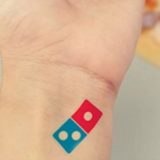
10. Domino’s Pizza: In September, a Russian Domino’s franchise owner launched the “Dominos Forever” campaign. Just tattoo Domino’s and you would get 100 Domino’s pizzas a year for life. First off, not sure that’s really the kind of promotion you want…tattoos can fade, sag, scar, etc. In this case, the response was overwhelming. Domino’s had to restrict the offer after they were inundated with people getting Domino’s tattoo. This whiz-bang campaign was supposed to last months, but it was pulled within a day. .

9. Movie Pass: In 2018 Movie Pass said it had 2,000,000 subscribers at $9.95/month, letting movie goers see a movie a day. That’s 30 movies a month. To the 2 Guyz, when something seems unbelievable, it usually is. Too much demand. Couldn’t sustain and had to take out loans. This product and marketing offering dropped from 30 movies a month to three, plus limited access to wide-release movies during peak demand. Not the same deal for consumers. Now it can’t generate little investor money. This reminds us of the dot.com bubble days, what startups believed that somehow, someway, horrible business models could somehow “make it up in the volume.” We think that Movie Pass likened their business to gym memberships, which go largely unused. Well, they proved that avid movie goers WILL use a “too good to be true” service.

8. Burger King: Burger King launched their Smartphone Social Media Campaign. The promotional idea included the activation of Burger King’s list of burger ingredients, which were posted on Wikipedia. Problem: Hackers altered and added special ingredients such as “cyanide.” The 2 Guyz teach that user-generated material has to have monitors and carefully watched and legally approved. Wikipedia is policed by a highly active fan-base, and is easily updated by users. In this way Burger King not only lost control of the message, the message changed…for the worse. Positive PR, turned negative or “negatory,” as they say on the street. Burger King slipped on a really big banana peel. As we say, “know thy customer, know thy competition, know thy media.”

7. LeVar Ball: Do we really need a reason? Okay, here’s a few. LeVar Ball talking “at,” not “with” any media. Media management is challenging for professionals. Letting LeVar Ball represent you to the media is like handing someone a stick of dynamite with a lit fuse. He also preceded to piss off or insult the Lakers, UCLA, President Trump, China, Steph Curry, and a host of others. Big Baller brand is laughed at by pros and financial experts. And his Big Baller Brand was given an F grade by the Better Business Bureau. .
 6. Papa John’s: John Schnatter, founder of Papa John’s, suing his own company, prompting loss of sales. Really? Pretty sure this isn’t in any business or Marketing textbooks, the strategy of suing your own company being good for business. Terrible for partners and for sales generation. Allegations of racial epithets, media rants, and blaming the NFL for bad pizza sales…not smart promotion of the brand. John’s action fit under many of the 9P’s of Marketing.
6. Papa John’s: John Schnatter, founder of Papa John’s, suing his own company, prompting loss of sales. Really? Pretty sure this isn’t in any business or Marketing textbooks, the strategy of suing your own company being good for business. Terrible for partners and for sales generation. Allegations of racial epithets, media rants, and blaming the NFL for bad pizza sales…not smart promotion of the brand. John’s action fit under many of the 9P’s of Marketing.

5. Diet Coke: Cringe worthy Diet Coke with flavors. Trying to sell Diet Coke by giving buyers the reasons, too, with the pixie dancing girl. A non-scientific poll conducted by the 2 Guys On Marketing on Gen Z and Millennials indicated this campaign, and the Super Bowl spot in particular, for “Twisted Mango”, was universally panned. Marketing “cool” is very difficult, and the risks frequently do not justify the rewards.
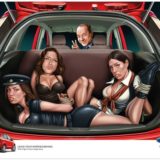
4. Ford: The world before #MeToo and after…it’s all different now! Ford stepped in the poo on this one by running a horrible visual in their ad, three women were bound, gagged, and stuffed in the trunk of a new Ford. Really Ford? Even before Harvey Weinstein this was bad taste at best. Press, media and PR was brutal.

3. Any 2018 Political Ad.:More specifically any 2018 political ad with Nancy Pelosi or Donald Trump. There were over 1,500 TV spots featuring President Trump or Minority Speaker Nancy Pelosi neither of them was running for a local or statewide office. David Ogilvy would say an ad is more successful when you put the “product” in. Were these selling local politicians, or building the brands of these two Washington politi-brands? And political advertising in general stooped to new lows of insensitivity, lying, and bad taste.
And tied for #1:

1. (tie) Michael Avenatti: Michael Avenatti’s Campaign for President ended with his arrest. He’s the lawyer for adult film star Stormy Daniels. A “spokesperson” with repeated exposure across mainstream media much of the year, he was arrested in Los Angeles on a domestic violence charge, according to several media outlets. Avenatti, freed on bail, said he was “not going to be intimidated.” Add the bankruptcy issues and partners’ disputes, plus eviction from his offices for lack of payment, this makes him one of our poster kids for bad Marketing planning. As a brand, his work has not gained him brand value, it has plummeted. He’s a “total” PR nightmare.
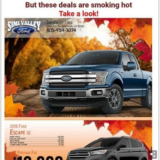
1. (tie) Ford: While the recent Southern California fires raged, taking lives, communities and homes, this local Ford dealership in Simi Valley, California ran an ad making light of the fires. Really dumb move. Cringeworthy or is it: “cringe-worthy?”.. it’s both, no matter how you spell it. Local business are like neighbors. Good neighbors? This was a bad move that should have NEVER passed approval.
Congratulations to all of this year’s winners. May you all hire smart professionals and/or graduates of our classes, who have hopefully learned to not to make the same mistakes as you!
]]>Papa John’s, the corporate entity, is taking John’s image off the ads and off the pizza boxes. Off ALL of their promotion and advertising. He’s not even allowed to have a Papa John’s corporate office. Plenty of examples under the 9P’s of Marketing to explore in a classroom of marketing and advertising students.
That led to discussing the issues fast food companies seem to have in this arena. Ronald McDonald came up. Created in 1963, it was NBC’s Willard Scott, who was a local radio personality at the time playing Bozo the Clown on WRC-TV in Washington, D.C. Scott was “Ronald McDonald, the hamburger-happy, fun-loving clown.” He was used in a couple of TV spots. Over the years, hundreds of Ronalds appeared in stores and all over the USA, in multi-media, franchisee promotion.
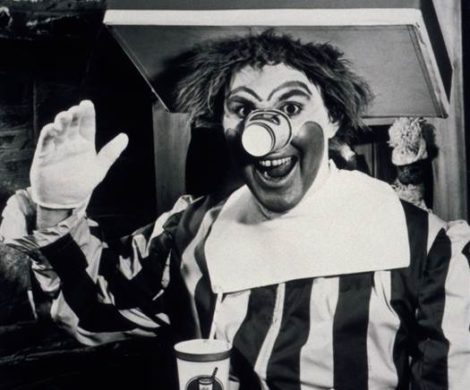
What happened to Ronald McDonald? On vacation? Health issues?
Well, there were a bunch of issues with Ronald. From his association with obesity and he’s a clown. Yes, a clown. Clowns can be charming…and they can be terrifying. (Fact: A recent survey indicated that 46% of Americans fear clowns. Source: Vox). Think about the increased clown exposure from the popular “IT” and “American Horror Story: Freak Show” and “American Horror Story: Cult.”
It was a couple of years ago that the Corporate Accountability International (CAI) in Boston recommended again that Ronald should be retired. They cited the health issue of childhood obesity in the U.S..
Back in 2011 CAI first ran ads and created web pages. They wanted McDonald’s corporate to retire the character or mascot. From their 2017 report “Clowning with Kid’s health: The Case for Ronald McDonald’s Retirement” the CAI research and report said the character is:
- “the product of a well-orchestrated and shrewd marketing strategy by America’s king of fast food.”
- “It’s not just the “nag factor… the practice the advertising industry invented to get kids to nag their parents for all sorts of products, including junk food.”
Why do companies use mascots, celebrities and spokespeople?
- They can attract attention
- Done properly, they can improve a company or product’s image
- They can help with a campaign feel and the advertising has more impact.
- They can boost a company or product’s awareness
- Break through clutter
- Exploit celebrity’s popularity
- These characters increase company or product’s credibility
- Companies use celebrities and others in marketing, sales meetings and store openings. These stars appear in events.
We’ll focus on mascot marketing in a future post, but suffice to say it can be the double edged sword. Camel’s Joe Camel cartoon worked for years in enticing kids to smoke Camel cigarettes, but is now a symbol of the evils of cigarette advertising.
Stars, mascots and characters can increase sales, but for these two, they may not be increasing store traffic and making the cash register ring.
]]>
What do the 2 Guyz On Marketing look for in spokespersons or celebrities?
Why use a celebrity or someone to front for your product or brand? It’s done because, when done well, it can…
- Attract attention
- Improve company or product’s image
- Boost company or product’s awareness
- Break through clutter
- Exploit celebrity’s popularity
- Increase sales
- Increase company or product’s credibility
- Use celebrity in marketing and sales meetings. Star can appear in events.
Strategic questions a brand manager or marketing manager should ask?
- Is the celebrity appropriate for our product or service?
- Does celebrity subtract from product or service?
- Does the celebrity add value? Or generate a good impression?
- Does the celebrity add to the product’s image?
- How much is the fee?
- How is the contract structured?
- Do you pay the celebrity their fee, which will decrease media exposure/expenses?
- What about the history and future of the celebrity exposure? What about “after hour” behavior, any criminal record, FTC issues? Health?
- Be sure celebrity uses and continues to use the product?
- Be sure the facts about the product are true and substantiated, before giving script to celebrity.
- You must disclose if the star or celebrity has considerable interest in the company or product.
We teach and consult that brand managers and advertising executives need to come up with the right idea or selling concept. That must be first. Then decide on the “celebrity” to present, sing or act. What you are going to say is more important than the “who.”
There is a downside. Not all relationships end well. Celebrities get in trouble, get injured, retire, etc. Your brand will be linked to the celebrity, for better or for worse. And when your contract ends, the celebrity’s life and career go on, but your relationship (and benefit) fades quickly.
It appears to us that Gerber has hit a homerun. Their new baby named “Lucas” won over 140K babies.
Celebrity endorsements and spokespeople work when they are truly connected to the brand. They are successful when the make positive connections three ways: between the celebrity, the brand, and the customer.
It’s a new world and a different world out there.
Lucas is cute, and he’s a special needs child. He has Down Syndrome. Smart marketing and good PR for Gerber. They are standing out and for a reason. Good for Gerber. Good for Lucas.
]]>
A million reasons not to continuing to watch the Grammys this week. I know a friend who posted she watched 30 minutes, zipped through the show and found only 20 minutes of good material.
Add that to the approximate 24% drop in viewership in key demographics and the characteristics under “People” (of the 9 P’s of Marketing).
The Grammys were something you could miss.
It wasn’t a good show, or a “product,” (also under the 9P’s of Marketing).
While people watched the 60th Annual Grammy Awards, the advertisers can’t be happy, it was the least-watched Grammys in nine years.
The 2 Guyz believe it was too much U2. Too much Sting. Not enough Lorde. Oh, she wasn’t asked. An industry protesting objectification of women…with seemingly countless performances objectifying women.
James Corbin was OK, but way too much promotion of CBS programming too.
Really the Grammys show was something to miss. Oh, much of the audience did. And the advertisers paid for it.
]]>
Over the years we hadn’t seen too many Sonic® TV spots, as Sonic was a Midwest chain, and while expanding, didn’t get to California until recently.
Sonic, “America’s Drive In,” has also adopted a new media strategy. They began advertising across the country, even in states they didn’t have drive-ins. They currently have more than 3,500 company and franchised locations around the country, but are only in 45 states.
We remember that in 2012 Sonic went back to the two advertising guys for Sonic after their CEO J. Clifford Hudson said their try at other new ideas and advertising executions “did not have the flexibility of moving across a variety of dayparts and messages.”
Sonic tried different executions for TV creative. They didn’t move the needle. Potential customers for Sonic didn’t see the spots in the sense that they were airing but didn’t get customers and fast food enthusiasts to go to Sonic.
For the 2 Guyz On Marketing it’s about more than generating awareness. It’s about making the cash register ring.
The TV approach and creative of their new campaign was the problem, Hudson told investors, that the length of time it took for one new commercial “to be even recognized as a Sonic promotion” was way too long. The 2 Guyz On Marketing would translate that into “Lack of sales. In retail, the goal is to make the cash register ring. When that doesn’t happen, people, and agencies, lose jobs.
So the 2 Sonic advertising guys are back. What is Sonic’s marketing objective? With a lot of experience in fast food and restaurant marketing, the 2 Guyz On Marketing (Larry and Brian) can pretty confidently say that is it to maintain or increase positive same-store sales growth. They advertise to support the stores and the brand, and know they are growing, so they are “softening the beaches” in the newer states.
We see the TV more. And they vary executions, frequently. They raise awareness. And they do plenty of promotions, about food and their food products.
The spots are interesting to us since they show product, and they make promotions work and generate store traffic.
Sonic wants brand recognition and wants a way to deliver copy points quickly and ultimately get store traffic and sales. That is what their 2 Sonic advertising guys do.
(Note: Sonic is a registered trademark of SONIC AMERICA’S DRIVE-IN BRAND PROPERTIES LLC)
]]>Here’s what we know: Smirnoff vodka is Russian but made in America. Is that a positive or a negative or two negatives?
Smirnoff wants to increase sales of their vodka, here in America. Pretty simple, right. Well, maybe not, with all of the competition. And we haven’t got into targeting or craft beers.
To increase awareness and sales, Smirnoff is using multiple promotional strategies right now.
Let’s use your brain?
What are the first couple of things you think about with the word “Smirnoff” or Smirnoff vodka? I bet it’s not America and actor, celebrity, Ted Danson.
As marketing Guyz, we know and teach that celebrities can increase awareness which may increase sales. We’ll see if Danson can stick and increase sales.
With their advertising, Smirnoff wants to entice millennial, multicultural consumers and others (“People” in the nine P’s) to purchase their vodka. Danson says in one of the videos, “We’re award winning, we’ve got great taste, been around since 1864 and we’re both surprisingly cheap.”
Danson is promoting the brand’s American heritage. Really, for a Russian vodka made here in America?
He uses a copy point that Smirnoff vodka has been made in America since the 1930s. Not sure it’s the right strategy, copy concept or will it sell vodka, as in Smirnoff vodka?
On another front, this week Smirnoff is using a line from a story about President Trump. The story was featured in the Washington Examiner with the headline “Smirnoff Vodka trolls Trump’s Russia controversy in new ad campaign.”
Smirnoff is also using politics to sell their liquor. Smirnoff Vodka is getting publicity by mocking President Trump’s favoritism to Russia in a new ad campaign. Is that good? It may or may not be?
The copy includes “But we’d be happy to talk about our ties to Russia under oath.”
It was only la short while back that Trump said that he would “100 percent” be willing to testify under oath about the ongoing Russia investigation.
To us, it’s obviously Smirnoff is doing a lot of PR. We’ve seen it. They are trying to create buzz and increase awareness. But Buzz doesn’t mean its making sales.
With my fellow Marketing Guy, Brian Hemsworth, we find current topics and follow them, teach them and consult about marketing, advertising and promotion
The best thing is that the ads feature the hot new (cold) drink, Moscow Mule. It will be replaced by something else soon.
The 2 Guyz on marketing are full service. Here to help.
So for the sake of teaching, what is a Moscow Mule? And who invented it?
The drink, Moscow Mule, is made with Vodka. You can use any vodka. Is it any more special if Smirnoff invented the drink?
The Moscow Mule is a cocktail made with spicy ginger beer, lime juice, vodka, with a lime wedge or slice.
Restaurants have had to add special copper mugs to serve them in. Some just use highball glasses. Not as cool or as trendy, especially for Millennials.
The ingredients to a Moscow Mule:
- Ice
- Four (4) of Ginger beer
- 1 1/2 oz. of Vodka,
- 1/6 oz. of Lime juice
Pretty easy to make: Combine ginger beer and the vodka in the copper mug or highball glass. Add lime juice. Add ice and lime wedge.
Like a perfect cocktail, Marketing blends a lot of research, trends, strategy, components, targeting and ad copy.
As 2 Guyz on marketing, we’ll be blending our views and insights on many subjects.
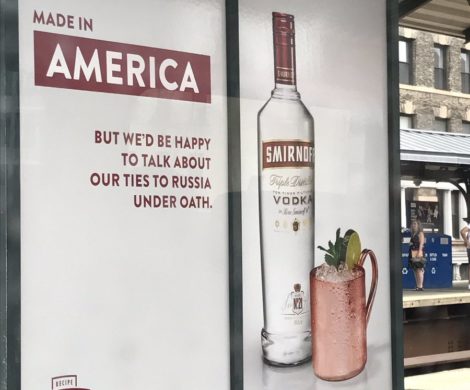
COUNTERPOINT FROM BRIAN: Larry is right, Smirnoff is #1, and they yes, the goal of this campaign is to try to capture new buyers. I’m not so sure it’s targeting millennials, and if it is, I don’t think this is a great effort.
First off, I have a hunch most millennials don’t have the foggiest notion who Ted Danson is, or know a thing about Cheers. Maybe they know he was on CSI. Maybe. But (no offense Ted) he was the old guy
Secondly, while Smirnoff is #1 in sales, their sales are flat. Right now the “craft” vodkas are kicking butt.
Here’s the challenge…millennials like their avocado toast, their craft beer, and their ill fitting hipster clothes that cost too much, but are brands that have cool Instagram accounts.
Is Ted Danson the right guy for this? Now don’t get me wrong, I think Ted Danson is the right guy…for a DIFFERENT target audience. He appeals to Larry and my generation, and we’re not millennials, but a long stretch.
I will say, I really like the bus shelter ad. It’s funny, clever, topic, and makes Smirnoff kind of cool. Ted Danson, not so much.
I also find fault in that there really is little similarity in these ads, and in my class, that would be a big “F” if someone turned in such dissimilar ads in the same campaign.
Ted gets some attention, for baby boomers, but I think Smirnoff misses the mark for millennials.
SMIRNOFF is a trademark of DIAGEO NORTH AMERICA, INC
]]>